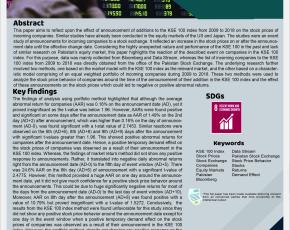Abstract
This paper aims to reflect upon the effect of announcement of additions to the KSE 100 index from 2009 to 2018 on the stock prices of incoming companies. Similar studies have already been conducted in the equity markets of the US and Japan. The studies were an event study of announcements for incoming companies to a stock exchange. It reflected an increase in the stock prices on or after the announcement date until the effective change date. Considering the highly unexpected nature and performance of the KSE 100 in the past and lack of similar research on Pakistan’s equity market, this paper highlights the reaction of the described event on companies in the KSE 100 index. For this purpose, data was mainly collected from Bloomberg and Data Stream, whereas the list of incoming companies to the KSE 100 index from 2009 to 2018 was directly obtained from the office of the Pakistan Stock Exchange. The underlying research further involved two methods, one based on the market model with the KSE 100 index as the relevant market, and the other based on a characteristic model comprising of an equal weighted portfolio of incoming companies during 2009 to 2018. These two methods were used to analyze the stock price behavior of companies around the time of the announcement of their addition in the KSE 100 index and the effect of these announcements on the stock prices which could led to negative or positive abnormal returns.
Key findings
The findings of analysis using portfolio method highlighted that although the average abnormal return for companies (AAR) was 0.16% on the announcement date (AD), yet it proved insignificant as the t-value was below 1.96. However, AARs were found positive and significant on some days after the announcement date as AAR of 1.49% on the 2nd day (AD+2) after announcement, which was higher than 0.16% on the day of announcement (AD-0), was found significant with a t-stat value of 2.7453. Similar reactions were observed on the 6th (AD+6), 8th (AD+8) and 9th (AD+9) days after the announcement with significant t-values greater than 1.96. This showed positive abnormal returns for companies after the announcement date. Hence, a positive temporary demand effect on the stock prices of companies was observed as a result of their announcement in the KSE 100 index. Whereas, the findings of market return method did not show any positive response to announcements. Rather, it translated into negative daily abnormal returns right from the announcement date (AD-0) to the fifth day of event window (AD+5). There was 24.6% AAR on the 6th day (AD+6) of announcement with a significant t-value of 2.4775. However, this method provided a huge AAR on one day around the announcement date, yet it did not give much confidence for a positive stock price behavior around the announcements. This could be due to huge significantly negative returns for most of the days from the announcement date (AD-0) to the last day of event window (AD+10). Moreover, AAR on 8th day after the announcement (AD+8) was found positive with a value of 10.79% but proved insignificant with a t-value of 1.5272. Conclusively, the results from the KSE 100 index method were found unfavorable for this study since they did not show any positive stock price behavior around the announcement date except for one day in the event window when a positive temporary demand effect on the stock prices of companies was observed as a result of their announcement in the KSE 100 index. However, the portfolio method, despite not showing any positive response on the announcement date, represented positive and significant average abnormal returns on some days in the event window after the announcement date.
Implications
This paper is an incentive for finance scholars and field analysts to thoroughly understand the highly volatile nature of Pakistan’s equity market PSX index, effect of announcements on the stock prices, the resulting possibilities of abnormal returns in the KSE 100 index, and the overall performance of individual stocks during the time period of 2000 to 2018. Understanding these factors can help finance scholars and field analysts in strategizing their financial decisions more efficiently. Moreover, this study provides access to better resources and experience in order to further explore how a change in the composition of equity market index, due to additions and deletions, can affect the stock prices of companies.













